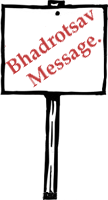|
|
|
|
|
|
| Message for the Bhadrotsav |
 In May 2005 a young Indian who has been brought up in England and has married and English lady was trying to contact the London Brahmo Samaj. He and his wife were expecting a baby in June and wanted to have a naming ceremony for the baby according to the Brahmo rites. In May 2005 a young Indian who has been brought up in England and has married and English lady was trying to contact the London Brahmo Samaj. He and his wife were expecting a baby in June and wanted to have a naming ceremony for the baby according to the Brahmo rites.
 After a month of the birth of the baby Rajen & Claire arranged for a Brahmo ceremony whereby prayers were said and hymns sung and baby Janak Luke Subberwal was named formally according to the Brahmo way. The parents of the baby were so happy that they made a donation to the London Brahmo Samaj. Rajen's mother sang a bhajan and her younger daughter in law (a Sikh) recited a small prayer from the Granthsahib after the naming ceremony was over. After a month of the birth of the baby Rajen & Claire arranged for a Brahmo ceremony whereby prayers were said and hymns sung and baby Janak Luke Subberwal was named formally according to the Brahmo way. The parents of the baby were so happy that they made a donation to the London Brahmo Samaj. Rajen's mother sang a bhajan and her younger daughter in law (a Sikh) recited a small prayer from the Granthsahib after the naming ceremony was over.
A year later another request came from a young Cambridge medical graduate - his father was Indian and mother English. He was going to marry an English Graduate from Cambridge University - Nancy. Nancy was the artistic director for a theatre, while the groom Bibekbrata was a doctor and a researcher. He too wanted to get married according to the Brahmo rites. The wedding took place in July at Syon Park near the Kew Gardens. The solemnity and simplicity of the prayers - the blessings and hymns of the ceremony was much appreciated by both the Indian and English audience. The parents of the groom made a donation to the Brahmo Sammilan Samaj.
Neither these young people were Brahmos or had any Brahmo connections - but somehow they were attracted to Brahmoism because they wanted to keep something of their own tradition. - their religion and culture. Rajen mentioned that "it is wonderful to be able to take part in a rite or form of worship based on Hinduism that is simple and can be understood by those, like my wife, from a Western Protestant or non-conformist tradition."
The main thing that appeals to people is the Brahmo liturgy has the traditional truths of Hinduism but without its cumbersome rituals. This is a happy medium and a middle path between the Western and Eastern thoughts. Claire's grandmother was a Tamil Brahmin, who married a teacher from Liverpool, in 1937, and they always said over 50 years later that one thing they never regretted was getting married!
One has to give credit to the liberal Western outlook that has brought up these young people - way from the ritualistic and sometimes fundamental backdrop of their native land. Claire and Rajen, Nancy and Bibekbrata were educated together (in Britain) and have shared common friends for years, shared a common culture in many ways. Every person differs from his parents, as change inevitably occurs through time.
The Brahmo mode of worship can be easily identified by members of both the religions. While it is more like the Unitarian religion in the belief of the One Eternal - the mode of worship of hymns and sermons makes it easily palatable to Christian audiences. The liturgy consists of the Vedic mantras but they are translated into the local vernacular and also English thus getting the full involvement of both the bride and groom - who can identify themselves with the vows that they are taking.
 So how does the Brahmo mode of worship appeal to these people? In November 2004 a certain Ms. Nameeta Shah, a Ph. D student of California, US approached this website to be married according to the Brahmo rites with Gaurav Anand an Engineer with GM at Detroit in Mumbai. The wedding was celebrated in January 2005 according to the Brahmo rites in Mumbai. Here again the liberal Western outlook of these young people helped them to identify a mode of worship which resembled the ancient scriptures of their native land but did not have the traditional rituals and dogmas. It is really commendable that young Hindus are looking for a moderate tradition for their wedding and choosing the Brahmo tradition. So how does the Brahmo mode of worship appeal to these people? In November 2004 a certain Ms. Nameeta Shah, a Ph. D student of California, US approached this website to be married according to the Brahmo rites with Gaurav Anand an Engineer with GM at Detroit in Mumbai. The wedding was celebrated in January 2005 according to the Brahmo rites in Mumbai. Here again the liberal Western outlook of these young people helped them to identify a mode of worship which resembled the ancient scriptures of their native land but did not have the traditional rituals and dogmas. It is really commendable that young Hindus are looking for a moderate tradition for their wedding and choosing the Brahmo tradition.
The author may be reached at bivchaudhuri@aol.com
|
|
|
|
|
|
|
|